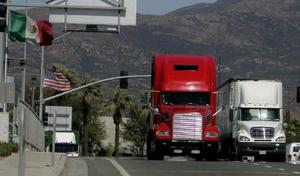Mexican trucks set to cross border again
President Obama and Mexican president Felipe Calderon have struck a deal that will allow Mexican trucks to cross the border once again; the new deal will end a sixteen year dispute which has effectively kept Mexican tractor-trailers from driving on U.S. roadways; the plan will allow an unlimited flow of trucks from Mexico to enter the United States so long as shipping companies register the vehicles, pass inspections, and do not break safety regulations; the new agreement could generate as much as $675 million in cost savings; each year there are roughly 4.5 million truck crossings and each crossing cost $150; last year more than $2.75 billion in goods travelled across the border

Mexican trucks bound for U.S. // Source: mexicotrucker.com
President Obama and Mexican president Felipe Calderon have struck a deal that will allow Mexican trucks to cross the border once again.
The new deal will end a sixteen year dispute which has effectively kept Mexican tractor-trailers from driving on U.S. roadways.
Under North American Free Trade Agreement (NAFTA), signed in 1994, Mexican trucks were to be allowed to carry goods across the border, but opponents in the United States blocked this provision of the trade agreement citing safety concerns.
Mexico responded by imposing $2.5 billion in tariffs on U.S. goods.
Efforts to end the stalemate stalled in 2007 after a pilot program that would allow Mexican trucks to enter the United States was defunded.
The new agreement was announced last week after President Felipe Calderon met with Obama in Washington.
In response to the announcement, Mexican Economy Minister Bruno Ferrari said, “This is a great step forward in our bilateral relations. The solution to this conflict represents a substantial advance for regional competitiveness, and, without a doubt, will offer new business opportunities for Mexican truckers.”
The plan will allow an unlimited flow of trucks from Mexico to enter the United States so long as shipping companies register the vehicles, pass inspections, and do not break safety regulations.
According to Dionisio Perez-Jacome, Mexico’s Communications and Transportation Minister, in order to be certified shipping companies must pass through the program’s three phases.
Mexican truck operators will first be issued a provisional authorization to enter the United States if they pass an initial inspection.
The second phase will last for three months and consist of thorough inspections of the vehicles as they cross the border. After the fourth month, the inspections will decrease in frequency. If the company successfully passes these inspections it is given a certification.
The final phase will grant shipping companies permanent authorization to operate trucks on U.S soil after eighteen months of successful operation. But if the company violates any safety regulations, the authorization will be revoked.
Mexico has agreed to drop half of its tariffs placed on U.S goods when the agreement is signed by both Presidents in June, and when the first permit for Mexican truckers is issued the remaining tariffs will we removed.
Under the agreement, Mexico reserves the right to introduce the tariffs once more if the United States violates any part of the deal.
Economic Minister Ferrari said, “The agreement achieved will reduce the costs of transporting goods between both nations.”
He believes the new agreement could generate as much as $675 million in cost savings. According to Ferrari currently only three trucks and three drivers are used to transport goods across the border, and it costs roughly $150 per crossing with roughly 4.5 million truck crossings annually.
Last year more than $2.75 billion in goods travelled across the border, which accounted for 70 percent of the total trade between Mexico and the United States.
